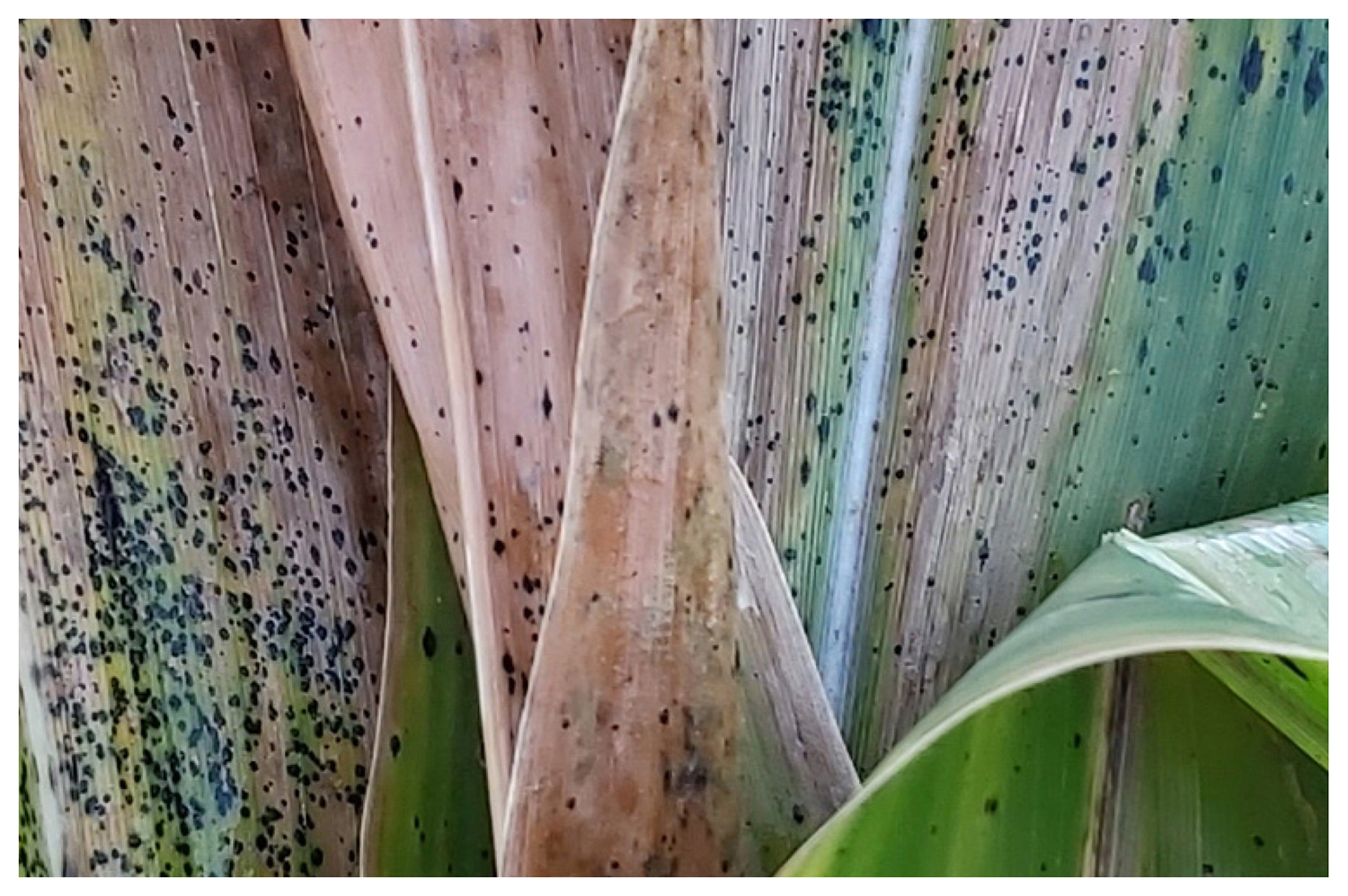___________________________________________________________________________________________________________________________________________

2024-2025 PRIDE Seeds Product GuideYou can find all of our products on the website, including supporting performance data and create your own personalized guide called My Guide. You can also download the digital version of our printed product guide which includes product comparison charts. |
Tar Spot
By now many have heard the crop losses associated with the corn disease Tar Spot. The complex disease is made up of two fungal pathogens: Phyllachora maydis and Monographella maydis.

Symptoms first develop from Phyllachora, spread by wind at temperatures 16-20°C paired with extended periods of high humidity. The initiated black spots do not significantly impact the plant, however as conditions persist the infection can evolve into a blight, destroying leaf tissue and impacting yield by upwards of 20-30bu. Fish-eye lesions are one of the most notable characteristics of the disease.
The state of Michigan first experienced tar spot in Allegan County in 2016. 2019 growing season proved 35 counties in southern Michigan and into the Thumb had some level of pressure.
So what do we know about PRIDE Seeds hybrids:
The past two growing seasons have provided the AgReliant Genetics Product Development team ample opportunity to assess trials grown in moderate to heavy pressure areas of the US corn belt. Many Core PRIDE Seeds hybrids are often used as checks, for comparison to Experimental and Competitor hybrids. Preliminary ratings have been established from field observations.
What work is being done:
- Trial work in areas of high incidence will continue on Experimental hybrids using Commercial products as benchmarks.
- Sites with high amounts of corn-on-corn acreage will influence site selection and opportunities to develop hybrids.
- Multiple years of in field observations and yield data will aid in development of hybrid ratings.
- Tar spot is difficult to artificially inoculate and it has not been effectively cultured as of yet.
- The AgReliant Native traits team, continues to work to identify tolerant hybrids and which traits could be utilized in breeding for increased tolerance to the persistent disease.
AgReliant Pathology:
When environmental conditions favor infection this disease can intensify very quickly. Cool and wet seems to be optimal with the emphasis on the moisture. Regular overhead irrigation, consistent rain patterns, or even a lot of long dew periods are contributors to the development. Years when these conditions happen earlier than normal have potential for higher presence and severity of tar spot.
As far as screening goes, we are looking into options for AgReliant. Since this pathogen cannot be grown on artificial media, we cannot inoculate plots as we do for other diseases. Closely monitoring plots in areas where conditions have been favorable for disease will be important. Being able to reliably assess a hybrid’s performance for tar spot is the most important target for our research with this disease.
There is variability of tolerance to the disease among hybrids. We do not know of any other desirable traits that can be associated with tar spot tolerance at this time. If a hybrid is blighted early enough to cause premature death, stalk cannibalization and lodging can be problems as well.
One of the biggest issues to combat with currently available tools is the rapid development of disease in susceptible hybrids. A weak hybrid can go from a little tar spot present to early death in a matter of two weeks. Better understanding when environmental conditions have been favorable and scouting those fields is key to protection. There are a number of fungicides that seem to perform well on tar spot. However, they do not prevent the disease, but rather seem to delay it’s development. That delay can be critical though depending on the growth stage it coincides with. This particularly was evident in the 2020 Growing season, as infection occurred during cool, high humidity, prolonged leaf wetness in Late August and took 3 weeks to be evident in fields. In many cases the corn was ½ milkline or more where yield impact is negligible.
Unfortunately, there is still a good deal to learn about this disease and the pathogen itself.
Click here for the PDF of this project and the rest of the PRIDE Seeds 2020 Agronomy Projects
THE PRIDE SEEDS ADVANTAGE
Farming is one of the most demanding industries in the world, subject to a variety of factors such as time, weather, and global pressures. You know this every time you look out the window and think about the field in front of you. Growers and dealers deserve an advantage: The PRIDE Seed Advantage.
LEARN MORETHE PRIDE SEEDS ADVANTAGE
Every year PRIDE Seeds works hard to produce leading-edge products that enable success where it matters most, on your farm. Our dedicated team strives to provide sales expertise, agronomy support, quality production, and service tailored to meet your needs.
LEARN MORE
-7.png?sfvrsn=87920db3_3)

Leave a commentOrder by
Newest on top Oldest on top